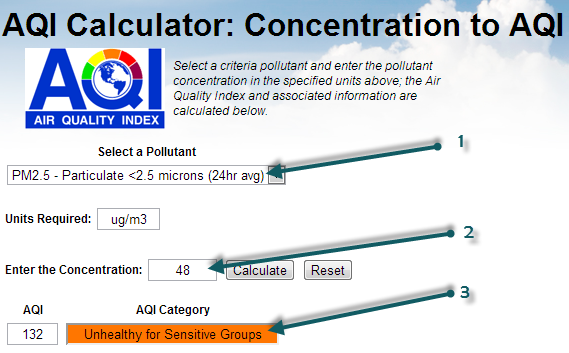In April 2014, the Singapore NEA has updated the PSI calculation to also include PM2.5. http://www.nea.gov.sg/anti-pollution-radiation-protection/air-pollution-control/psi
В связи с недавним смогом в Юго-Восточной Азии из Индонезии, поразившим Сингапур, а теперь и Малайзию , у нас появилось много вопросов о том, почему существует разница между данными, которые можно прочитать на веб-сайте Сингапурского агентства NEA ( nea.gov.sg ), и проектом World Air Quality Index в Сингапуре. веб-страница .
Например, вот что сегодня можно прочитать на сайте АЯЭ:

По какой-то исторической причине Сингапур использует PSI ( стандартный индекс загрязнителей ) для оценки качества воздуха. На изображении выше цифра 1 соответствует значению PM10, которое используется для оценки PSI. Значение 67(/59) можно прочитать как 67 мкг/м3, что соответствует PSI, равному 59. PSI оценивается как максимум индивидуального PSI для каждого из загрязняющих веществ: PM 10 , SO 2 , NO 2 , O. 3 (озон) и CO 2 .
PSI(Singapore-North) = max( PSIPM10-based, ... PSIO3-based )= max (59, ..., 77) = 77
При этом интересно то, что в этой же таблице данные PM2,5 также представлены в последнем столбце (см. 3). Эти данные предоставляются только в мкг/м3 (см. 2), без преобразования в нечто вроде PSI (т.е. преобразования массы PM2,5 в индекс загрязнения или качества). Однако такое преобразование существует и определяется Агентством по охране окружающей среды США . Самый простой способ выполнить преобразование — использовать онлайн-калькулятор, доступный на сайте airnow.gov :

If you select the PM2.5 (1), then enter the mass concentration of 48 (2), can click on Calculate, you will obtain the AQI of 132 (3). So, based on the PM2.5 AQI conversion, the PSI that is used for Singapore could be extended (let's call it PSI++) to also take into account the PM2.5 information. In which case, the PSI++ would be the maximum of the regular PSI (based on PM10 only) and the PM2.5 AQI:
PSI++ = max( PSI, AQIPM.25 ) = max( 77, 132 ) = 132
This PSI++, that is commonly referred as AQI (or Air Quality Index), is what is being used on the the World Air Quality Index project, for all the cities (provided PM2.5 is available for the city). And this explains why the values are different between the NEA website and the World Air Quality Index project.
Moreover, when doing the convertion, make sure you use the 1-hour reading for the PM2.5 concentration rather than the 24-hours averaged value, as shown on the below image:

http://www.haze.gov.sg/haze-updates/pollutant-concentrations/type/PM25-1Hr
If you want to know more about PM10 vs PM2.5, and especially why PM10 is still used, please check the faq entry about why is PM2.5 often higher than PM10? Is PM10 still a relevant measure?
--
For more information about specific countries or continent, please refer to those articles: Thailand and Malysia - India - China - Hong Kong / Canada (Air Quality Health Index) - South America - Australia - Quebec and Montreal - Singapore - Poland - Indonesia .
For information about the 24 hours averaging used or Ozone and Particulate Matter (PM2.5), please refer to those two articles: Ground Ozone Index - PM2.5 Instant Cast
